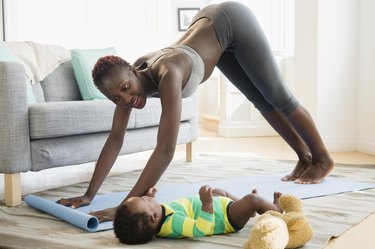
Despite the many physical changes that come with pregnancy and childbirth, our health care system is, in many ways, still under-serving birthing people in the postpartum period.
For most, the protocol goes like this: You give birth to your baby and are discharged a couple days later (slightly longer if you've had a C-section). Then, six weeks later, you go through a routine gynecological exam where your ob-gyn will check to see if you've healed properly, ask a few questions about your mood and mental health, tell you whether or not you're ready to start exercising and having sex again and offer some advice about birth control and family planning.
Video of the Day
Video of the Day
That's pretty much it.
It's no wonder so many birthing people are left feeling unseen and confused as they attempt to navigate postpartum life and the many difficulties and ailments that can occur after childbirth.
But in recent years, health care officials have started to rethink the way we treat postpartum people. Organizations like the American College of Obstetricians and Gynecologists (ACOG) have pushed for changes that could help providers more effectively address and prioritize birthing persons' short- and long-term health and wellbeing.
One such suggestion from ACOG encourages doctors to assess the need for postpartum physical therapy — a form of treatment which, therapists and MDs agree, could play a major role in how we heal after birth.
The Benefits of Postpartum Physical Therapy
Many birthing people report feeling mostly recovered by six or eight weeks postpartum, but it's fairly common to still not feel like yourself, according to the American Academy of Family Physicians (AAFP).
For example, certain muscle groups, like your core and pelvic floor, may take longer to heal and may even require additional intervention — that's where pelvic floor physical therapy comes in.
"After birth, a physician or midwife will check for healing of the vaginal or abdominal tissue, but they do not usually check for muscle function or how someone is able to move," says Rachel Parotta, DPT, a physical therapist specializing in prenatal, postpartum and pelvic health.
"A physical therapist can check the strength, coordination and flexibility of the core and pelvic floor muscles," Parotta says. "They can also observe how someone is able to move when getting out of bed, squatting and lifting. These are movements that many postpartum people will have to perform repetitively as they care for their baby."
Outside of helping with general everyday functioning, physical therapy may also benefit those who are dealing with specific postpartum issues.
"I believe physical therapy should be offered to everyone after birth," says Christine Sterling, MD, board-certified ob-gyn and founder of Sterling Parents. "Parents with conditions like stress incontinence, pelvic organ prolapse and diastasis recti can all benefit from physical therapy. I've had patients regain control over their bladders, improve their core strength, lessen back pain and generally just feel stronger and more secure in their bodies."
And before you hop back onto your stationary exercise bike, it may be wise to see a physical therapist to ensure you're not pushing your body beyond its current limits.
"Physical therapists can guide people in how to safely and progressively return to an exercise program," Parotta says.
"Postpartum folks are generally given the 'all clear' to return to exercise at six or eight weeks postpartum, but many physical therapists believe that the week six 'clearance' should actually be the start of a progressive rehabilitation program, similar to how athletes rehabilitate after injury, rather than just returning to running or weightlifting," Parotta adds.
How Your Body Changes After Pregnancy and Birth
Your Core
During pregnancy, the muscles that make up your abdominal wall (especially your rectus abdominus, or "six pack" muscles) have to stretch, and the linea alba — a band of connective tissue that runs from your sternum to your public bone — has to thin and pull apart, according to the Cleveland Clinic.
For some, pregnancy can significantly weaken the linea alba, which in turn causes the ab muscles to separate — a condition known as diastasis recti, per the Cleveland Clinic. Some signs of diastasis recti include:
- A visible bulge that protrudes just above or below the belly button
- Coning or doming when you contract your ab muscles
- Difficulty lifting objects, walking or performing everyday tasks
- Pain during sex
- Pelvic and/or hip pain
- Lower back pain
- Poor posture
- Urinary incontinence
- Constipation
- Feeling weak in your abdominals
If you're dealing with diastasis recti, jumping back into exercise without proper core rehab could do more harm than good.
"If someone has a significant diastasis recti and/or an abdominal hernia, a physical therapist can design a safe and progressive abdominal exercise program to help restore core function," Parotta says.
Your Pelvis
As your belly grows during pregnancy, your spine and pelvis have to support a heavier load. In the later stages, this causes the pelvis to shift forward (also called an anterior pelvic tilt), which changes your lower back posture and even alters your center of gravity, according to June 2015 research in the Journal of Physical Therapy Science.
Hormonal changes in pregnancy can also weaken ligaments in your hips and pelvis, according to the National Association for Continence (NAFC).
While the pelvis typically returns to its original position and the muscles and ligaments regain strength after pregnancy, this isn't always the case. The pelvis may remain in an anterior tilt and lead to issues like back pain, according to August 2017 research in the Journal of Back and Musculoskeletal Rehabilitation.
What's more, weakened muscles and ligaments in the pelvis are associated with urinary incontinence, sexual dysfunction or pain during sex, separation of the pubic symphysis bone and pelvic organ prolapse — a condition in which the organs in your pelvis (i.e. your vagina, cervix, uterus, bladder, urethra and rectum) fall or "drop" toward or through the opening of the vagina, according to the FDA.
Pregnancy and vaginal birth also put pressure on your pelvic floor muscles, or the group of supporting muscles and ligaments sitting at the bottom of your pelvis. Both can result in a weakened pelvic floor, or in some cases, an overly tense or "tight" pelvic floor, each with its own set of symptoms, per the NAFC.
Symptoms of a weakened pelvic floor include:
- Urinary incontinence, increased urgency or more frequent urination
- Bowel incontinence (think: uncontrollable farts and/or poops)
- Pelvic organ prolapse
- Sexual dysfunction
Symptoms of a tense pelvic floor include:
- Constipation
- Pain during sex
- Pelvic pain
- Inability to empty your bladder completely
- Painful urination
Orthopedic issues such as low back pain and pelvic girdle pain (pain in the pubic or groin region) are also common after having a baby, according to the NAFC.
When to Seek Care
"If a person is continuing to experience pain, incontinence or pelvic pressure after six to eight weeks postpartum, I would advise them to see a physical therapist," Parotta says.
Tell your doctor if you're experiencing any of the symptoms listed above, and don't be afraid to ask for a referral to physical therapy if you're concerned about returning to an exercise program safely, or if things just aren't feeling right in your body.
Your ob-gyn may be able to refer you to a physical therapist with specific training in postpartum recovery and pelvic health.
What to Expect From Postpartum PT
At your first postpartum physical therapy visit, you'll sit down with a therapist for a comprehensive evaluation, where they will ask you about your symptoms. They will also perform a physical examination with some movement tests to assess how well your core and pelvic floor muscles are functioning.
After the initial consultation, your therapist will create an individualized treatment plan that will address any issues you're having, which will include manual release techniques (such as massage or myofascial release), stretches and strengthening exercises they will work on with you at each visit.
The plan will also likely include exercises for you to do at home that will help to reduce pain and improve the strength and function of your muscles.
Postpartum Exercises to Start With
In an ideal world, every birthing person would be evaluated for and given access to the care they need to heal postpartum. But: "There is a problem with access to care," Parotta says. "There are not enough physical therapists trained in pelvic health, and there are not enough providers that can see clients from a variety of insurance plans."
What's more, the mental and physical load on birthing parents is heavy as it is. "The current system requires a person to piece together their own postpartum team, including lactation support, mental health support and pelvic health support, in addition to the many pediatrician appointments that are needed for the baby," Parotta says.
"It is a lot to ask new parents to research their own care providers, inquire about insurance and go to numerous physical locations to have their postpartum needs met. Ideally, this type of care would be offered in a single location and covered by the health care system as standard postpartum care," Parotta adds.
Because finding care can be challenging, Parotta shares three postpartum exercises you can start with at home to help with rehabilitation and strength-building:
Diaphragmatic Breathing
- Lie on your back with your knees bent and feet planted on the floor.
- Place your hands on the bottom portion of your rib cage, then slide your hands slightly away from each other.
- On an inhale, try to breathe into your hands, which should move toward the sides of the rib cage.
- On your exhale, allow the rib cage to return back to the starting position. Instead of focusing on the abdomen with this breathing, try to focus on expanding the rib cage 360 degrees, as if opening and closing an umbrella.
- Repeat for 10 breaths. Can be repeated up to 3 sets of 10 per day.
Why it works: "The diaphragm, abdominal muscles and pelvic floor muscles all work together," Parotta says. "Prior to pregnancy, these muscles often coordinate well without conscious effort."
It can take more effort to get them working well together after pregnancy, though.
"In the postpartum period, we believe it is helpful to work on rebuilding this coordination to create a strong foundation for movement and exercise," Parotta says.
Deep Abdominal Engagement
This exercise integrates the breathing pattern of the first exercise in a standing position.
- Stand in a comfortable position.
- As you inhale into the rib cage, try to allow the abdomen to expand or "let go" toward the floor. On exhalation, try to engage the abdominal muscles from the 'bottom up' or from the pubic bone up to the bellybutton.
- Hold this engagement for about 3 seconds.
- Release and repeat for 10 repetitions. Can be repeated up to 3 sets of 10 per day.
Why it works: "It's sometimes difficult to 'feel' or 'find' the deeper abdominal muscles postpartum," Parotta says. "Oftentimes, if we try to engage the abdominals, we will see only the upper part of the abdomen engage. In this exercise, we try to find the abdominals 'from the bottom,' as this portion is often more challenging to 'find' or 'feel.'"
Sit to Stand
- Sit at the edge of a sturdy chair or couch. Place your hands on your hips or on your thighs (if you need extra support). If the seat feels too low to stand up without using your hands, you can add a pillow to make the seat higher
- While sitting at the edge, lean slightly forward from your waist.
- Press down through your heels and stand up. If you feel abdominal or pelvic discomfort while standing, you can try to add a gentle abdominal engagement as you stand (as in the previous exercise).
- Make sure you are close to the couch or chair and sit back down in a controlled manner.
- Repeat for 10 repetitions. Can be repeated up to 3 sets of 10 per day.
Why it works: "Taking care of yourself and a baby requires full-body strength," Parotta says. "This exercise helps to rebuild strength in the hips and thighs to help you complete daily tasks. It also acts as a progression back to more advanced exercises, such as squats."
There are also several postpartum movement programs available online that can help you progressively build strength and functionality in your body, such as the Body Ready Method (created by an exercise physiologist and movement specialist) and Get Mom Strong (created by a pre- and postnatal corrective exercise specialist).
Just be sure to talk to your doctor before starting any new exercise program.
- Cleveland Clinic: Diastasis Recti
- Journal of Physical Therapy Science: Changes in balance strategy in the third trimester
- National Association for Continence: Why You Shouldn't Ignore Your Pelvic Floor After Childbirth
- Journal of Back and Musculoskeletal Rehabilitation: Relationship between mechanical factors and pelvic tilt in adults with and without low back pain
- Food and Drug Administration (FDA): Pelvic Organ Prolapse (POP)
- American College of Obstetricians and Gynecologists: "Optimizing Postpartum Care"
- American Academy of Family Physicians: "Recovering from Delivery (Postpartum Recovery)"
Is this an emergency? If you are experiencing serious medical symptoms, please see the National Library of Medicine’s list of signs you need emergency medical attention or call 911.


